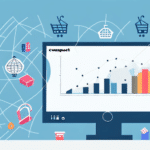Importance of Pricing Strategies in E-commerce
Pricing plays a pivotal role in the success of an e-commerce business. It not only affects demand levels and profit margins but also shapes the overall revenue trajectory. With the e-commerce market projected to reach $6.3 trillion by 2024[1], implementing effective pricing strategies is crucial for staying competitive and ensuring sustainable growth.
One key objective of pricing strategies is to attract customers while maximizing profitability. To achieve this, e-commerce businesses must consider various factors that influence their pricing decisions.
Among the most critical factors are competition and target market. Monitoring competitors' pricing allows businesses to position their products effectively within the market. However, it's essential to avoid engaging in price wars, which can erode profit margins and harm brand reputation.
Understanding the target market is equally important. Different customer segments exhibit varying price sensitivities, necessitating tailored pricing approaches. For instance, luxury products can command higher prices due to perceived value, whereas budget-conscious consumers may prioritize affordability.
Analyzing Costs: Understanding Cost of Goods Sold (COGS)
The Cost of Goods Sold (COGS) is a fundamental component in pricing decisions for e-commerce businesses. COGS encompasses all expenses related to the production or procurement of a product, including raw materials, labor, and overhead costs. Accurately calculating COGS is essential for determining the minimum viable price that prevents losses.
For example, a study by Shopify indicates that businesses with precise COGS analysis are 30% more likely to achieve sustainable profitability[2]. This highlights the importance of thoroughly understanding each product's specific COGS, whether it's a handcrafted item with higher material costs or a digital product with minimal production expenses.
Moreover, identifying areas to reduce COGS—such as negotiating better rates with suppliers or optimizing production processes—can enhance profit margins. Continuous evaluation and optimization of COGS contribute significantly to the financial health of an e-commerce business.
Competitive and Dynamic Pricing Strategies
Competitive Pricing
Competitive pricing involves setting product prices based on the prices of competitors. This strategy is particularly effective in markets with similar products and high competition. By aligning prices with industry standards, businesses can attract customers seeking comparable options.
However, merely matching competitors may not be sufficient. According to a Harvard Business Review article, companies that differentiate their value proposition alongside competitive pricing enjoy higher customer retention rates[3].
Dynamic Pricing
Dynamic pricing is the practice of adjusting prices in real-time based on various factors such as demand, inventory levels, and customer behavior. Retailers like Amazon and airlines frequently use dynamic pricing to optimize revenue[4].
For example, surge pricing used by ride-sharing services like Uber adjusts fares during peak demand periods to balance supply and demand. This approach helps businesses maximize profits while ensuring availability during high-demand times.
Psychological Pricing Tactics
Psychological pricing leverages consumer psychology to influence purchasing decisions. Strategies include:
- Charm Pricing: Setting prices slightly below a round number, such as $19.99 instead of $20, to make products appear more affordable.
- Price Anchoring: Introducing a higher-priced item first to make subsequent prices seem more reasonable.
- Scarcity Marketing: Creating a sense of urgency with limited-time offers or limited stock notifications to encourage immediate purchases.
Research by the Journal of Consumer Research demonstrates that charm pricing can increase sales by up to 24% for certain product categories[5].
Discounts, Promotions, and Segment-Specific Pricing
Discounts and promotions are widely used to attract customers and boost sales. Effective use of these tactics can lead to increased customer acquisition and retention. However, overusing discounts may devalue the brand and diminish perceived product quality.
Targeted Promotions
Offering personalized promotions based on customer data can enhance their effectiveness. For instance, providing exclusive discounts to loyal customers or first-time buyers can incentivize repeat purchases and foster customer loyalty.
Segment-Specific Pricing
Adjusting prices for different customer segments based on purchasing power and preferences helps cater to diverse market needs. Subscription models or installment payment options can also appeal to various financial preferences, expanding the customer base.
Pricing Optimization and Testing
Pricing optimization involves systematically determining the most effective prices to maximize revenue and profitability. Techniques such as A/B testing and multivariate testing allow businesses to experiment with different pricing levels and evaluate their impact on sales.
According to a study by Price Intelligently, businesses that adopt data-driven pricing strategies can improve their revenues by up to 25%[6].
Data-Driven Pricing
Utilizing data analytics to understand customer behavior, market trends, and competitive pricing enables more informed pricing decisions. Implementing machine learning algorithms can further enhance dynamic pricing strategies by predicting demand fluctuations.
Managing Additional Costs: Shipping and Handling
Shipping and handling costs significantly impact product pricing and customer satisfaction. Transparent and competitive shipping rates can influence purchasing decisions, as studies show that free shipping offers can increase conversion rates by up to 30%[7].
Businesses must balance the need to cover shipping costs with the desire to offer attractive rates to customers. Strategies include optimizing logistics, partnering with reliable carriers, and offering various shipping options to meet customer preferences.
Future Trends in E-commerce Pricing Strategies
The e-commerce landscape continues to evolve, driven by technological advancements and shifting consumer behaviors. Emerging trends in pricing strategies include:
- Subscription-Based Pricing: Offering products or services on a subscription basis provides a steady revenue stream and enhances customer loyalty.
- Value-Based Pricing: Focusing on the perceived value to the customer rather than solely on costs or competitor prices can differentiate brands and justify premium pricing.
- AI-Powered Pricing: Leveraging artificial intelligence to analyze vast amounts of data and automate pricing adjustments enhances responsiveness to market changes.
Staying abreast of these trends allows e-commerce businesses to adapt and implement innovative pricing strategies that align with market demands and consumer expectations.
Conclusion
Effective pricing strategies are essential for the success of e-commerce businesses. By understanding costs, analyzing the competitive landscape, leveraging psychological tactics, and optimizing pricing through data-driven approaches, businesses can enhance their profitability and customer satisfaction. As the e-commerce sector continues to grow and evolve, staying informed about emerging pricing trends and technologies will be crucial for maintaining a competitive edge in the market.




















